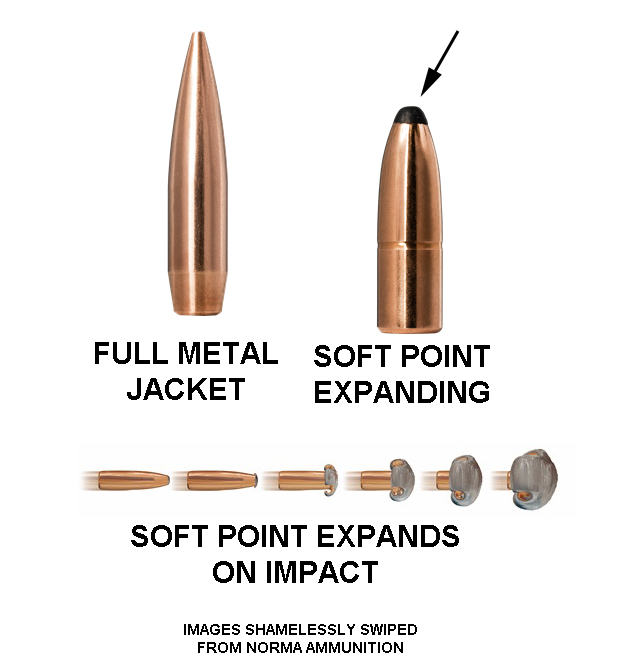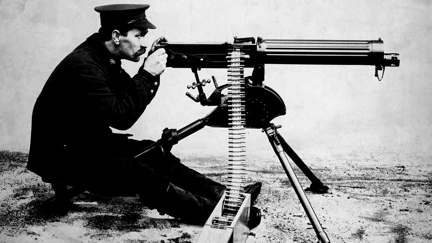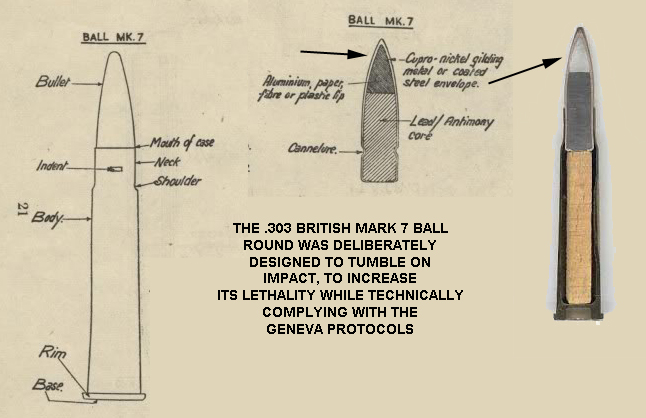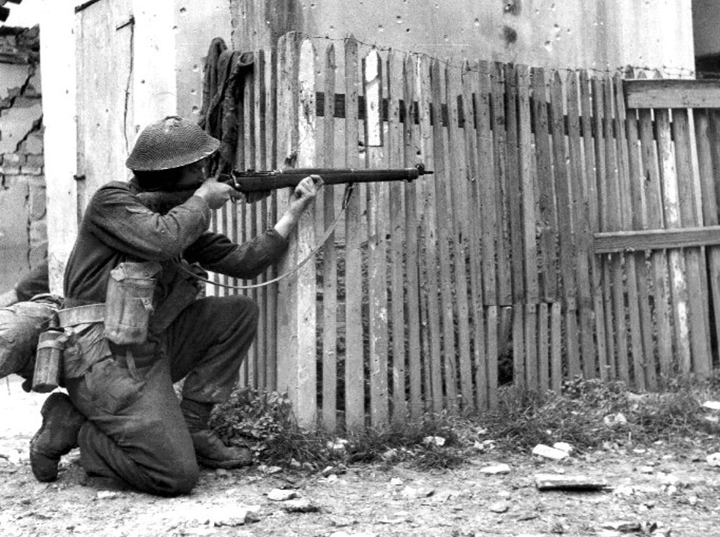“The military uses FMJ bullets because they want to wound an enemy, not kill him:
a wounded man is more of a burden than a dead one.”
God alone knows how this particular myth gained currency and more especially why it persists. It is utter nonsense. First of all, having served in the military, I can tell you that even experienced non-coms repeat this baloney. It was told to them when they were in training so they repeated it when they in turn became trainers, obviously without thinking about it.
The fact is that all soldiers, sailors, airmen, and marines, are taught to shoot to kill. Period. Training with a rifle (or a handgun, if you’re an officer) is focused on hitting “center of mass,” a tactic that increases the number of hits with—necessarily—an inevitable increase in the number of lethal hits. The intention of shooting at all is to at least seriously disable but preferably to kill your adversary. All military forces, without exception, train their soldiers this way. It is only civilians going through defensive shooting courses and some police agencies who are trained to shoot to stop an enemy (or at least to tell the judge, “All I wanted to do was stop him, I didn’t intend to kill him, Your Honor”).
Even drill instructors who implicitly believe this myth perforce train their charges to shoot to kill. Why do you want to kill him? Because a dead man can’t hurt you: he can’t shoot back or throw a grenade. But a wounded man can, so it is highly inadvisable to merely wound him. If it were somehow deemed desirable to wound him, military personnel would be trained to shoot for the legs or arms, but I can assure you that I wasn't and neither is anyone else.
The key to the origin of this particular myth, I think, is the universal use of the full metal jacket bullet by military forces, which has a relatively low lethality compared to hunting bullets. Despite the famous movie of that name, the full metal jacket (“FMJ”) bullet isn’t endowed with special lethality: far from it. An Army study has shown that something on the order of 95% of people shot in the chest (“center of mass”) with full metal jacket bullets do not die. Why not? Because FMJ bullets don’t expand. Instead they drill nice neat holes. These holes are nowhere near so damaging as the wounds produced by the bullets typically used in hunting.
 Hunting bullets are designed to expand, to do maximum tissue damage, and to kill as close to instantly as possible. Anyone who has seen the frightful wounds inflicted on a deer by, say, a Remington Core-Lokt or a Winchester Silvertip bullet will understand that survival of the animal—even with a chest wound—is nearly impossible; in fact it's undesirable. It is precisely because FMJ bullets are not so lethal as soft-pointed expanding ones are that most states specifically prohibit their use on game: the hunter’s goal is a clean kill, which isn't an outcome that can be counted on using FMJ bullets.
Hunting bullets are designed to expand, to do maximum tissue damage, and to kill as close to instantly as possible. Anyone who has seen the frightful wounds inflicted on a deer by, say, a Remington Core-Lokt or a Winchester Silvertip bullet will understand that survival of the animal—even with a chest wound—is nearly impossible; in fact it's undesirable. It is precisely because FMJ bullets are not so lethal as soft-pointed expanding ones are that most states specifically prohibit their use on game: the hunter’s goal is a clean kill, which isn't an outcome that can be counted on using FMJ bullets.
This difference in lethality is so well understood that sometimes during a war a soldier or partisan found in possession of soft-point hunting ammunition can be executed on the spot—as many have been. The Geneva Protocols, the so-called “Laws of War” (as if such a thing as war could have “laws”), to which nearly all nations are signatories, that specifically prohibit the use of weapons “intended to cause unnecessary suffering” has often (erroneously) been credited with requiring the use of FMJ bullets. They don’t and they aren’t the reason military forces use FMJ’s.

The real reason FMJ bullets are used by the military forces is simple: not because they “wound rather than kill,” but because they work better in automated weapons. The soft lead tip of an expanding hunting-type bullet is easily battered by the action of a machine gun or even a semi-automatic rifle. But the FMJ bullet, covered by a hard layer of gilding metal, is not only resistant to deformation, it’s fairly slick so it runs up a feed ramp with less potential for jamming. That it also technically meets the demands of the various “Laws of War” is a side benefit, but not the real reason for its use.
 Nevertheless, the military forces of many many nations, whose top echelons are fully cognizant of the advantage to their side of killing enemy soldiers have found ways around the “requirement” of the “Laws of War” by developing FMJ bullets that are very, very damaging when they hit. The old .303 Mark VII bullet used by the British for decades is an example. It’s an FMJ, all right, but underneath the hard outer jacket the lead core is fronted by a lighter section of aluminum or fiber (excuse me, “aluminium” or “fibre”). That bullet is stable in flight but it will tumble (“yaw”) badly on encountering flesh and bone, creating horrific exit wounds.
Nevertheless, the military forces of many many nations, whose top echelons are fully cognizant of the advantage to their side of killing enemy soldiers have found ways around the “requirement” of the “Laws of War” by developing FMJ bullets that are very, very damaging when they hit. The old .303 Mark VII bullet used by the British for decades is an example. It’s an FMJ, all right, but underneath the hard outer jacket the lead core is fronted by a lighter section of aluminum or fiber (excuse me, “aluminium” or “fibre”). That bullet is stable in flight but it will tumble (“yaw”) badly on encountering flesh and bone, creating horrific exit wounds.

A similar situation existed with the 5.56x45 rounds initially issued by the US military for the M16 rifle. The bullet in the M193 Ball (the ammunition that we were issued in Vietnam) weighed 55 grains and the rifling twist of 1:14" used in the earlier M16 didn’t really stabilize it fully; on encountering a human body it tended to tumble; the bullet was fairly fragile, tending often to fragment, both things which caused massive damage. (The 5.56x45 round has its own mythology, which will be addressed in a separate essay.)
So what about this business of “A wounded man requires more resources than a dead one”? Maybe, but only temporarily. A wounded man can recover: it might take 6 months to a year or more, but many—most—do. On the other hand, a dead man cannot recover; moreover it takes at least 18 years to replace him. The American experience in the Vietnam war is instructive in this respect. Small arms are nowhere near so lethal as artillery (the great battlefield killer in both World Wars). In Vietnam a total of 2,700,000 men served in-theater; it was a conflict in which small unit combats (none bigger than a battalion, usually smaller) predominated. The 58,220 official death total represented 2.1% of the total number of men engaged, but combat deaths (mostly from small arms fire) were 47,434, about 1.7%. Yes, a wounded man takes a lot of care and effort and resources to save; certainly the US military spares no effort to save a wounded man from death, but in most cases he recovers to the point where he can return to duty, even if at a limited level. Many a man has been shot, recovered, and gone back into active service.
_1973.jpg)
I was in the USAF with a man who’d been shot at Hue with an AK-47 bullet: he said “It felt like I’d been kicked in the chest, and the next thing I knew I was in a hospital ship.” The bullet passed entirely through, exiting his back half an inch to one side of his spine: had it hit his spine or aorta he’d have died, but he didn’t because that FMJ bullet did not expand. It did some serious damage on the way through but he lived, recovered, and went back to active duty. Nor did it take 18 years for him to do so. The high survival rate of people shot with military ammunition reinforced—and in fact probably generated—the myth that “wounding is better than killing.” But it is a myth nonetheless, no matter what your Drill Instructor in Basic Training told you.
| OPENING PAGE|
|SEASON LOGS |
| HUNTING | GUNS | DOGS |
| FISHING & BOATING | TRIP REPORTS | MISCELLANEOUS ESSAYS |
| CONTRIBUTIONS FROM OTHER WRITERS|
| RECIPES |POLITICS |